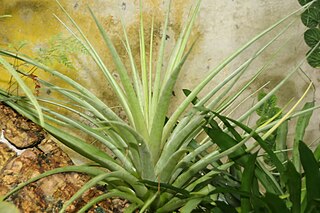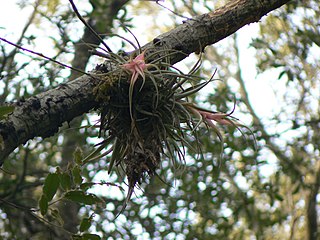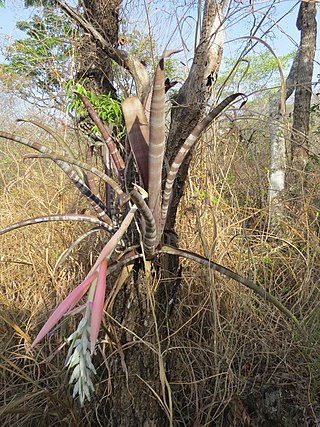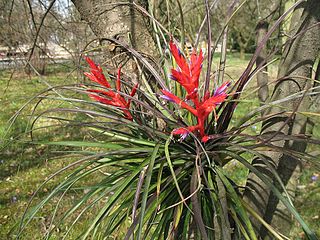
Aechmea nudicaulis is a bromeliad species in the genus Aechmea, which is often used as an ornamental plant. This species is native to Central America, the West Indies, central and southern Mexico, and northern and central South America.

Tillandsia balbisiana, common name northern needleleaf, is a species of bromeliad in the genus Tillandsia. This species in native to Mexico, Central America, Colombia, Venezuela, the West Indies, and Florida.

Tillandsia bulbosa, the bulbous airplant, is a species of flowering plant in the genus Tillandsia. It is widespread across Central America, the West Indies, southern Mexico, and northern and eastern South America.

Tillandsia capitata is a species of flowering plant in the family Bromeliaceae. It is native to Mexico, Honduras, Cuba and the Dominican Republic.

Tillandsia erubescens is a species of epiphytic plants of the genus Tillandsia. This species is endemic to Mexico, found over much of the country from Chihuahua to Oaxaca.

Tillandsia polystachia is a species of flowering plant in the genus Tillandsia. This species is native to Central America, the West Indies, Bolivia, Colombia, Brazil, Ecuador, Mexico and Venezuela.

Aechmea bracteata is a plant species in the genus Aechmea. This species is native to Central America, Mexico, Colombia, and Venezuela; it is also reportedly naturalized in the Bahamas.

Aechmea lueddemanniana is a species of bromeliad in the genus Aechmea. This species is native to Costa Rica, Guatemala, Belize, Honduras, Nicaragua and southern Mexico as far north as Veracruz.

Aechmea mexicana is a plant species in the genus Aechmea. This species is native to central and southern Mexico, Central America, Colombia and Ecuador.

Billbergia pallidiflora is a species of flowering plant in the family Bromeliaceae. This species is native to Central America and western Mexico.
Catopsis nutans is a species in the genus Catopsis. This species is native to Florida, Central America, Greater Antilles, Venezuela, Colombia, Bolivia, and Ecuador.
Catopsis subulata is a species in the genus Catopsis. This species is native to Mexico, Guatemala, and Honduras.
Catopsis wangerinii is a species in the genus Catopsis. This species is native to Central America, Colombia, and Mexico.
Catopsis wawranea is a species in the genus Catopsis. This species is native to Costa Rica, Belize, and Mexico.

Fosterella micrantha is a plant species in the genus Fosterella. This species is native to Mexico, Guatemala, and El Salvador.

Tillandsia chlorophylla is a species of flowering plant in the genus Tillandsia. This species is native to Belize, Guatemala, and southern Mexico.
Tillandsia festucoides, commonly known as the fescue airplant, is a species of bromeliad that is native to the Greater Antilles, Mexico, the Cayman Islands, and Central America.

Tillandsia magnusiana is a species of flowering plant in the genus Tillandsia. This species is native to southern and western Mexico, El Salvador, Nicaragua and Honduras.
Tillandsia pseudobaileyi is a species of flowering plant in the genus Tillandsia. This species is native to Mexico, Guatemala, El Salvador, Honduras, and Nicaragua.

Catopsis floribunda is a species in the genus Catopsis. This species is native to the West Indies, Venezuela, Honduras, Oaxaca, and Florida.














